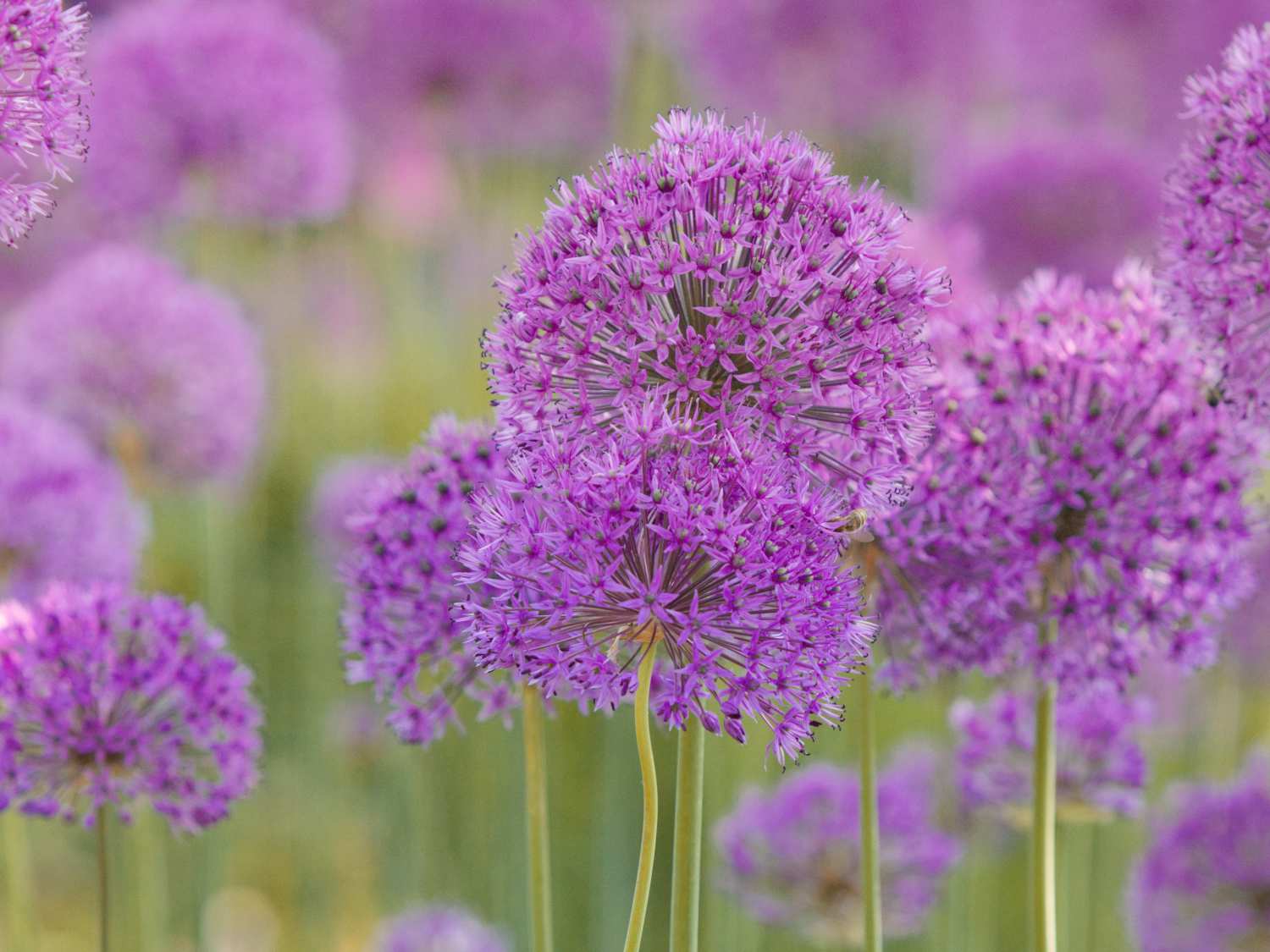
The ornamental onion, also known as Allium, is a fascinating plant that adds a touch of elegance and beauty to any garden or landscape. With its distinctive globular flower heads and slender, hollow stems, the ornamental onion stands out among other plants, captivating the attention of both garden enthusiasts and nature lovers.
But there’s more to the ornamental onion than meets the eye. In this article, we will explore 20 intriguing facts about this unique plant, delving into its origin, characteristics, and the various varieties that exist. From its historical significance as a medicinal plant to its use as a culinary ingredient, the ornamental onion has a rich and diverse background that spans many cultures and time periods.
So, whether you’re an avid gardener seeking to expand your knowledge or simply an admirer of the natural world, this article will take you on a journey through the fascinating world of ornamental onions.
Key Takeaways:
- Ornamental onions are visually stunning, low-maintenance plants that repel pests and attract pollinators. They have a long history of cultivation and diverse medicinal, culinary, and symbolic uses.
- With over 700 species, ornamental onions offer vibrant flowers, unique leaf shapes, and architectural structure. They are versatile, drought-tolerant, and make delightful cut flowers, adding elegance to any garden.
Aesthetically Pleasing Bulb
The ornamental onion, also known as Allium, is a visually stunning bulb plant that adds a touch of elegance to any garden or landscape.
Diverse Species
There are over 700 species of ornamental onion, offering a wide range of colors, sizes, and shapes to choose from.
Deer and Rodent Resistant
Ornamental onions are known for their strong smell, which deters deer and rodents from eating them.
Global Distribution
The ornamental onion is native to various regions around the world, including Europe, Asia, and North America.
Medicinal Uses
In traditional medicine, certain species of ornamental onion are used to alleviate respiratory problems, high blood pressure, and digestive issues.
Long Blooming Period
Ornamental onions produce vibrant flowers that can last for several weeks, providing a stunning display in gardens and floral arrangements.
Attracts Pollinators
The colorful flowers of the ornamental onion attract bees, butterflies, and other pollinators, making them an excellent addition to any pollinator-friendly garden.
Edible Varieties
Some species of ornamental onion, such as Allium schoenoprasum (common chives), are edible and often used as culinary herbs.
Vibrant Purple Flowers
One of the most popular varieties of ornamental onion, Allium giganteum, produces large globes of vibrant purple flowers that can reach a height of up to 4 feet.
Symbolic Meanings
In different cultures, ornamental onions symbolize various meanings, including beauty, protection, and strength.
Companion Planting Benefits
Planting ornamental onions near other vegetables can help repel pests and enhance the growth and flavor of neighboring plants.
Easy to Grow
Ornamental onions are relatively low-maintenance plants that thrive in well-draining soil and full sun to partial shade.
Drought Tolerant
Many species of ornamental onion have adapted to withstand dry conditions, making them a resilient choice for water-wise gardens.
Seed Propagation
Ornamental onions can be propagated from seeds, allowing gardeners to grow a large number of plants with minimal effort.
Unique Architectural Structure
The spherical flower heads of ornamental onions add an architectural element to garden designs, creating focal points and visual interest.
Diverse Leaf Shapes
Ornamental onions have a variety of leaf shapes, including flat, strap-like, and twisted forms, adding texture to garden landscapes.
Cut Flower Delight
Ornamental onions make stunning cut flowers that can be enjoyed indoors, adding a pop of color and elegance to floral arrangements.
Natural Pest Repellent
The pungent smell of ornamental onions acts as a natural deterrent against pests, keeping aphids, slugs, and other unwanted visitors away from your garden.
Long History of Cultivation
Ornamental onions have been cultivated for ornamental purposes for centuries, with records dating back to ancient civilizations like the Egyptians and Greeks.
Versatile Garden Plant
From borders and rock gardens to containers and meadows, ornamental onions can thrive in various garden settings, showcasing their beauty and versatility.
Conclusion
In conclusion, ornamental onions are fascinating plants that can add beauty and intrigue to any garden or landscape. With their unique aesthetic appeal, wide range of colors, and impressive resilience, it’s no wonder why they have become a popular choice among gardeners and landscaping enthusiasts. From their ability to repel pests to their medicinal properties, ornamental onions truly have more to offer than meets the eye. Whether you choose to grow them for their gorgeous blooms or to ward off harmful insects, these plants are sure to captivate and delight. So why not incorporate some ornamental onions into your garden and discover the wonders they have to offer?Don’t miss out on the opportunity to enjoy the beauty and benefits of ornamental onions. Start exploring the different varieties available and experiment with incorporating them into your garden. With their intriguing facts and captivating qualities, you’ll surely be amazed by these remarkable plants.
FAQs
1. Are ornamental onions easy to grow?
Yes, ornamental onions are generally easy to grow. They are hardy plants that can tolerate a wide range of soil conditions and temperatures. However, they do prefer well-draining soil and full sun exposure.
2. Can ornamental onions be grown in containers?
Yes, ornamental onions can be successfully grown in containers. Just make sure to choose a large enough pot to accommodate their tall stems and extensive root system. Also, ensure that the container has good drainage to prevent waterlogging.
3. Do ornamental onions have any medicinal properties?
Yes, ornamental onions have been used in traditional medicine for various purposes. They are believed to have antimicrobial and anti-inflammatory properties. However, it’s always best to consult with a healthcare professional before using them for medicinal purposes.
4. Are ornamental onions attractive to pollinators?
Yes, ornamental onions are known to attract pollinators, such as bees and butterflies, with their vibrant blooms. They provide a valuable source of nectar and pollen, making them beneficial plants for supporting pollinator populations.
5. How do I divide and propagate ornamental onions?
Ornamental onions can be divided and propagated by separating the bulbs in late summer or early fall. Gently remove the bulbs from the soil and separate them into individual sections. Replant these sections in a well-prepared bed or container, making sure to provide adequate spacing.
6. Do ornamental onions have any pest problems?
Ornamental onions are generally resistant to pests and diseases. In fact, their strong smell and pungent taste can repel many insects and animals. However, they may occasionally be affected by aphids or onion maggots. Regular monitoring and appropriate pest control measures can help keep these issues under control.
Ornamental onions aren't your garden's only stunning options. Hepatica's delicate, star-shaped blooms make these perennial plants a springtime sensation. Landscape designers can transform ordinary spaces into breathtaking outdoor escapes. Fatsia japonica's glossy, evergreen foliage adds a tropical flair to any ornamental plant collection. Explore more captivating plant facts and gardening inspiration in our other articles.
Was this page helpful?
Our commitment to delivering trustworthy and engaging content is at the heart of what we do. Each fact on our site is contributed by real users like you, bringing a wealth of diverse insights and information. To ensure the highest standards of accuracy and reliability, our dedicated editors meticulously review each submission. This process guarantees that the facts we share are not only fascinating but also credible. Trust in our commitment to quality and authenticity as you explore and learn with us.


